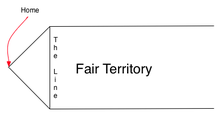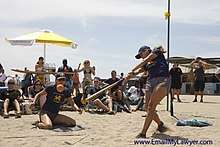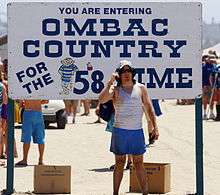Over-the-line
Over-the-line is a bat-and-ball sport, a game related to baseball and softball. Like those games, you have the batter, pitcher, and fielders. Because a game requires only three people per team, it is considerably easier to get a good informal game going. Equipment consists of a rope (or lines marked in the sand), an "official" softball bat & a "official" Orange rubber DeBeer softball. No gloves are allowed while fielding in the Men's divisions unless 60+ years of age. However, gloves are allowed for the women's divisions. Junior (typically 20 years or below) events also allow a glove on defense. A single golf glove may be used when batting. Game play, however, is very different.

The name "over-the-line" is a registered trademark of the Old Mission Beach Athletic Club (OMBAC) of San Diego, California, which organizes an annual tournament that is one of the city's largest summer social events. It is also known as OTL (also trademarked by OMBAC).[1] OMBAC allows other organizations to license the trademark for their own events for a nominal fee.
An over-the-line court is normally made up on a beach and comprises a triangle and an open ended rectangle marked by ropes or lines in the sand. The base ("The Line") of the triangle is 55 feet (17 m) long, and the distance from the line to the opposite point ("Home") is also 55 feet (17 m). The rectangle is composed of two parallel ropes or lines that extend out indefinitely away from home starting from the two ends of The Line and at a right angle to The Line. The area between the parallel ropes and over The Line is fair territory. Everything other than the triangle and fair territory is foul territory.

Unlike in softball, the batter and pitcher are on the same team. The batter stands at Home. The pitcher stands anywhere in front of The Line, not in the triangle. Fielders (the other team) stand behind The Line, in fair territory. The objective for the batter is get a hit which is to hit the ball into fair territory without a fielder catching it. A hit may also be made when the fielder who catches the ball crosses over the line (or the line's extension) or drops the ball in either fair or foul territory. No bases are physically run, however.
An out is made if (a) the ball is hit into your triangle, (b) a batter gets a strike (swings and completely misses), (c) the defenders catch the ball without crossing over The Line or its extensions, (d) a batter has two fouls (a foul is a ball that lands in foul territory, a pitch taken at or a balk), (e) a player bats out of order or (f) either the pitcher or batter touch but do not catch a struck ball (if the pitcher or batter catch it there is a no pitch). Unlike baseball and softball, where the foul lines are in fair territory, the ropes are in foul territory. Three outs end the half-inning, as in regular baseball and softball.
The scoring system is as follows:
- The third hit in an inning scores one run and each subsequent hit scores another run and
- A home run (a ball that lands past the Fielder furthest from The Line, not over, just needs to be past) without it being touched by a Fielder scores a run and the unscored hits that preceded it. The hits are then reset to zero.
Annual tournament

Over-the-line was first played in Mission Beach, San Diego, California in the 1950s[2] and continues to thrive in the area. It is seen largely as a novelty game in the inland counties (and, debatably, the beach counties as well), but still persists as a physical education activity at local high schools, and most visibly in the practice of an annual tournament held on Fiesta Island. By far the locale's most notorious activity, the annual "OMBAC World Championship Over The Line Tournament", organized by Old Mission Beach Athletic Club, is a prominent event in San Diego's beach sports life. The tournament has a history of adult themed team names, often with variations of the sport's equipment — namely bats and balls — that are seen as explicit enough to discourage most youth attendance. Over the years, the tournament gained a reputation for its hedonistic and sexual overtones. To help emphasize the sport rather than the spectacle, OMBAC has made strides to cut back on these and some of the tournament's other, more offensive, elements. The tournament is much more than "beer, babes, and bats on the beach."
The annual World Championships now gathers more than 1200 teams from all over the world. They compete in many different divisions. The divisions are separated by age and gender. Players from 18 to 80 years of age are participating. There are men's and women's teams and the sport is taken very seriously by the players. In 1977 players got gray hairs because of the stress There is even an OTL Players Association that was established to help further the sport and hosts several additional tournaments per year.
The tournament has gained a negative stigma by many who have never attended. As the population that began the event continues to age (the tournament began in 1954), the game garners increasing acceptance from the San Diego populace and governing bodies. Because of the sport and the party atmosphere this event fosters, OMBAC once again welcomed about 60,000 spectators over the two July weekends it was held in 2011.
References
- Buckheit, Mary. "Play ball ... and enjoy the sights". ESPN.
- Jurjevics, Rosa (12 July 2007). "Their Own Little World: Mission Beach". San Diego Reader.